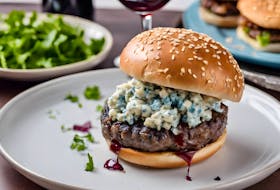Restaurants and food businesses don’t just feed us. Our regular spots offer pleasure, kinship and familiarity. Not being able to frequent these places, to chat with the owners and staff, to sit for a while, is a great loss. Even a week into the COVID-19 pandemic, I can feel it.
Scrambling to come up with solutions as the situation unfolds, the stress restaurant owners and staff are under is immense. Operating on notoriously slim profit margins at the best of times — an average of three to five per cent — some restaurants won’t recover from this temporary shuttering. Establishments that can, have kept their doors open by moving exclusively to takeout and delivery, and some are selling gift cards, merchandise and pantry boxes.
Ordering delivery is a crystalline way to support restaurants while in self-isolation. Restaurants and food businesses need our patronage, but is it right to put others at risk to satisfy our hunger for something other than pantry cooking?
According to Chris MacDonald , who teaches ethics at Ted Rogers School of Management, Ryerson University, “obligation number one is to listen to public health authorities and to heed their advice.” As long as officials deem food delivery to be acceptable, which they do, we should focus instead on ways to reduce the risk to ourselves and couriers. Keep your distance (preferably via contactless delivery), avoid physical contact, pay and tip electronically (not with cash), and tip well.
“These people are now effectively frontline workers in a pandemic, and are often in pretty precarious employment situations,” adds MacDonald. “I for one am going to be upping my normal tipping behaviour to recognize the fact that these folks are doing a potentially dangerous job, and that their entire livelihood could collapse any minute if the public health restrictions change.”
Uber Eats, which has waived delivery fees for independent restaurants in Canada and the U.S., announced Monday that it will provide contactless delivery upon request. DoorDash, Foodora and SkipTheDishes also offer a contactless delivery option, but again, customers must request it when placing their order. On March 17, the Justice for Foodora Couriers group posted a statement on Twitter asking that customers “think of (them) and take a couple easy steps to keep (them) safe and supported” during the pandemic.
“Couriers need the work and the income — as gig workers we are not entitled to any of the financial support governments are implementing for workers,” the group said, before highlighting the importance of selecting contactless delivery, tipping generously when you place the order, considering the distance between your home and the restaurant you’re ordering from, and supporting their collective efforts.
The gig economy, while responsible for creating flexible employment opportunities for many, has inherent risks and lacks a social safety net. “One of the things that I think we will see (once we get back to normal) is a reckoning around the whole gig economy model,” says Jo-Ann McArthur, president of Nourish Food Marketing . “It has been starting to move to more of a collective, potentially unionized model, and I think you’ll start seeing that as well. (People will gain an) understanding that these workers are incredibly vulnerable.”
Customers and couriers can both take steps to mitigate the risks of delivery, but meal delivery companies have responsibilities as well, beyond offering the option of contactless delivery and waiving fees. Knowledge of how to stay safe during a pandemic is “incredibly unevenly spread across the population,” MacDonald explains. Managers are obligated to be informed and advise their workers of best practices.
“With that extra access to information comes first, responsibility,” says MacDonald. “And at least in the case of the larger organizations — even though it’s going to be painful financially — they do have some financial capacity to say, ‘Look, we’re buying gloves, we’re buying masks. Whatever it is that public health authorities tell us we need, we’re going to do it because we’re going to rely on our employees and they need to know that they can rely on us.’”
Four per cent of all Canadians have used food delivery apps more often since the beginning of the outbreak, according to a new survey. The data was collected “right in the middle of panic-buying season,” from March 13 to 15, says principal investigator Sylvain Charlebois, a professor in food distribution and policy at Dalhousie University . As people adapt to the “new normal” over the next few weeks, he expects this number to grow.
“‘How do we download an app, and how do you use an app to order food, and what about e-commerce?’ And ‘How comfortable am I to allow someone I don’t know to pick and choose the food that I’m going to buy?’ There are all of these things that are probably going to be processed in consumers’ minds over the next little while,” says Charlebois. “Canadians are slowly looking at options. I think the four per cent is indicative of the fact that people are starting to process the idea that maybe there are other ways to buy food, and not just showing up physically at a store.”
As we’ve seen in parts of China under lockdown, food couriers have been providing a lifeline for the millions confined to their homes, as well as healthcare professionals fighting the disease at the forefront. “(Food delivery) is absolutely fundamentally essential,” says Kerry Bowman , professor of bioethics and global health at the University of Toronto. “When we look at the most vulnerable people within society, whether that be age-related or other risk factors, it’s going to meet a lot of people’s needs.”
Some people have a deep-seated fear of food shortages, Bowman explains, and knowing food delivery is an option helps alleviate anxiety. “There’s a psychological benefit to it, and I don’t take psychological benefits lightly these days. We need all the psychological benefits we can have, because one of the things going on with the situation right now is we don’t really know how powerful the psychological effects of all this social distancing will be,” he adds. “Social distancing is morphing into almost a quarantine … and because we’ve never really done this before on such a huge scale, we don’t know what this is going to be like for a lot of people. (There is a) strong indication there will be a lot of variation in how people respond to it, but anything that’s going to bring the edge off, like food ordering, I think is a very good thing.”
Much more than a mere practicality — a means of moving food from one place to another — delivery also serves as a reminder of our daily rhythms. Restaurants and other food businesses formed the fabric of our regular lives. Under typical circumstances, more than half of our meals are eaten out of home, says McArthur, adding that she expects to see a trend towards the hyperlocal as people look for ways to aid their neighbours.
It’s comforting to reflect on the intangible gifts of restaurants in addition to the well-crafted meals. Continuing to support our communities — and couriers — through food delivery is an immediate way to show our affection and appreciation from a distance.
Copyright Postmedia Network Inc., 2020








